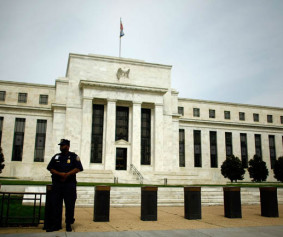Fed Tapers By $10 Billion – Markets Soar Anyway
Thursday, December 19th, 2013 @ 10:58PM
Between the Lines
by Gary D. Halbert
At the conclusion of the Fed Open Market Committee meeting yesterday, the official policy statement confirmed that the central bank will scale back its monthly bond and mortgage purchases by $10 billion. It will reduce its monthly Treasury bond purchases and mortgage-backed securities purchases by $5 billion each.
The statement also said the Fed intends to continue tapering its QE purchases at upcoming meetings, although it did not specify any specific schedule. However, in his press conference afterward, Bernanke said he expected the taper would continue at a “measured pace” and be wound down “late in the year, certainly not by the middle of the year.”
The other change of note in the policy statement was new language that indicates the Fed intends to keep short-term interest rates at 0.0% to 0.25% even longer than previously indicated. In recent months, the Fed had said it might start to raise short-term rates if the unemployment rate reached 6.5%. Now the FOMC says it might be even longer:
“The Committee now anticipates, based on its assessment of these factors, that it likely will be appropriate to maintain the current target range for the federal funds rate well past the time that the unemployment rate declines below 6-1/2 percent, especially if projected inflation continues to run below the Committee’s 2 percent longer-run goal.” [Emphasis added, GDH.]
To almost everyone’s surprise, stocks exploded higher shortly after the policy statement was released. The Dow soared over 200 points just minutes after the statement came out and closed up almost 300 points on the day. Most forecasters had predicted that stocks would fall if the Fed decided to taper. Even Treasury bonds and notes rose slightly in price after the announcement. What a surprise!
Apparently the markets were comforted by the news that the Fed intends to keep short-term interest rates near zero for considerably longer than had been expected. Earlier, the Fed had suggested it would keep short rates near zero through 2014. Now they are suggesting that ZIRP (zero interest rate policy) could extend through 2015 as well.
Others suggested that the spike in the equity markets yesterday was because the Fed wouldn’t have taken this first step to reduce asset purchases unless it was increasingly confident that the economy is finally on a stronger track. We’ll see about that. The key will be whether or not consumer confidence, currently in the tank, will rebound strongly in the weeks ahead. That has to happen if this economy is going to gain some greater momentum.
Finally, in his press conference after the release of the FOMC’s policy statement, Bernanke said that Fed Vice-Chair Janet Yellen was fully onboard with the latest decision to taper QE purchases. There has been much speculation since President Obama selected Yellen to succeed Bernanke whether she would agree to taper, or would argue for even more QE going forward. The FOMC policy statement confirms that she voted to taper.
In my E-Letter on Tuesday, you will recall that I brought to your attention the fact that the FOMC discussed cutting the interest rate it pays commercial banks that leave “excess reserves” on deposit with the Fed. Currently, the Fed pays 0.25% on such deposits. Yet the minutes from the October 29-30 FOMC meeting (released On November 20) revealed that there was discussion about reducing or eliminating that interest rate.
Some on the FOMC argued that if the 0.25% interest rate on excess reserves was reduced or eliminated, that would stimulate banks to draw down that money and make more loans. That assumes, of course, that there is demand for such loans. In any event, no formal action was taken at the October 29-30 FOMC meeting.
The question remains as to whether this discussion was continued at this week’s FOMC meeting. Since there was nothing in the policy statement regarding cutting the 0.25% interest on excess reserves, it’s probably safe to assume that no change was made this week. However, the issue may well have been discussed further at this week’s meeting. We will know for sure when the minutes of this week’s meeting come out in January. I’ll keep you posted.
In closing, I have suggested in the last few weeks that Bernanke may have wanted to initiate the controversial “taper” on his watch before he leaves the Fed in January. After all, he started QE, so why not begin the end of it on his watch as well? Just my opinion.
Good luck with your last-minute shopping!
Posted by AIA Research & Editorial Staff
Categories: Between the Lines


